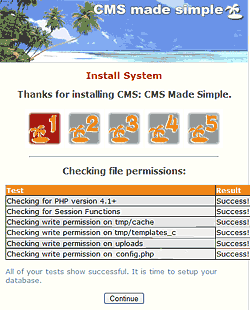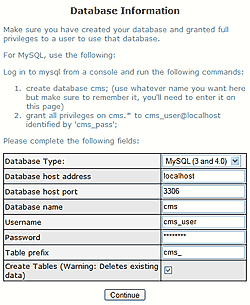This page in: English - Deutsch - Español - Français - Italiano - Lietuvių - Nederlands - Norsk - Polski - Русский - Svenska - Tiếng Việt - عربي - 日本語 简体中文
Shell installation
Although this step-by-step guide seems rather intricate at first glance, if you work from step to step without worrying about the next ones, all should run smoothly. You could also check the requirements before you start.
Step 1
Login to your shell account via ssh (or telnet if you must)
cd to your www-root dir
Step 2
Check the latest release tar.gz link from latest stable release if you want to use CMSMS in a production environment.
The link above takes you to a download page displaying many alternative links. Make sure your browser is displaying the url of any links that you hover over - in Safari, you need to display the Status Bar. Hover over the link for the latest filename ending in tar.gz, see what url is displayed and note the ID number in the middle of the url. This ID is the key to uploading to your server the correct tar.gz file. At the time of writing (29 May 2007) the ID number is 1246.
(If using Safari, and doubtless other browsers, you can Ctrl-click on the link and then save the whole url as a bookmark.)
In your ssh window issue a command like the following, with the current ID number and CMSMS version number replacing the numbers you see here:
wget http://dev.cmsmadesimple.org/frs/download.php/1246/cmsmadesimple-1.0.6.tar.gz
You might at this stage want to log in to your server with your ftp program to make sure you have successfully uploaded the tar.gz file.
Then issue a command like the following but with the current CMSMS version number in place of "1.0.6":
tar -zxf cmsmadesimple-1.0.6.tar.gz
Step 3
Now you have new directory named something like cmsmadesimple-1.0.6 and two options. You can install CMSMS in that directory or rename it whatever you like. For the rest of this howto to you need to cd yourself into that folder. If you have not renamed the folder, you would issue:
cd cmsmadesimple-1.0.6
Step 4
Now for the script to access the folder properly, you need to change permissions of the following files and directories on the server. (Note: 777 has pontential security risks and may allow hackers to upload files to these directories to run phishing sites etc. If security of your web site is important, set these folders to CHMOD 775 or tighter.)
chmod 777 tmp/templates_c; \ chmod 777 tmp/cache; \ chmod 777 uploads; \ chmod 777 uploads/images; \ chmod 777 modules
(should work with copypaste)
Note: If you know that php is run with your own user permissions you can skip this and the next step. Also note that you can chown these directories to whatever user apache runs as to accomplish an appropriate permission scheme. For example, chown -R www-data tmp or chown -R www-data uploads, would give these directories to an appropriate user under Ubuntu, and you wouldn't then need to open them up to 777.
Step 5
Issue
touch config.php; chmod 666 config.php
Note: The only time you wouldn't need to create a config.php file is if the web server has access to write to that directory (in which case that file will be automatically created during the installation). More often than not, they don't.
Step 6
Create an empty database. Depending on your host you may use a program like PHPMyAdmin, or your hosts control panel.
You can select any name, username and password for the database (just make sure to remember it!). But to make it even easier when you install CMSMS (step 7-10), you can use the following:
- Database name: cms
- Username: cms_user
- Password: cms_pass
Note: Some hosts only allow you to use one database. Then you will have to use that database (and the username and password that you use to login to your database). If that is the case, you can skip step 6. Only make sure to use a prefix for the tables (step 10 below) that separates the CMSMS tables from other tables that you also may be using in the same database.
Step 7
Now, in your browser, type the URL of the directory where you put the files (step 3), e.g. http://www.yoursite.com/cmsmadesimple-0.12.1/index.php. This should take you to the installation wizard. If it doesn't, go to http://www.yoursite.com/cmsmadesimple-0.12.1/install/install.php
Or change folder name according to your selection
Step 8
The first screen (see image to the right) is checking that you have set the right permissions. If all tests are succesful, click Continue.
If you receive any errors, make sure you've given the folders the correct permissions.
Step 9
You should now select a user name, e-mail address and password for the admin.
Note: this is for access to the CMS Made Simple administration once the installation is finished; these are not the user name and password that you gave when creating the database (step 6)
Step 10
In the next step you need to enter the database information. For Database name, Username and Password, enter the same information as when you created the database in step 6. In most cases all other settings can be left as they are.
Ask your hosting company if you encounter difficulties.
Note: Uncheck the box Create tables if you use an existing database with content that you don't want to remove (for example if you upgrade or repair). Otherwise leave as is.
Step 11
In the next screen, if all is [done], everything was installed successfully and CMSMS is ready for use! Congratulations!
It is wise to write down the CMS Document root, the path to the Document root and the Querystring in case you need this information.
Step 12
The final step is to remove the install directory for security reasons, HOWEVER!! If you have performed an upgrade you may need to run a procedure to update the database. Login as administrator - you may see a red warning box - follow the instructions BEFORE deleting the install directory.
When the red warning disappears then issue
chmod 444 config.php; rm -rf install
Step 13
Go to your site and read the first page carefully.
Have a look at the post installation optional settings like pretty URLs.
This page in:
English -
Deutsch -
Español -
Français -
Italiano -
Lietuvių -
Nederlands -
Norsk -
Polski -
Česky -
Русский -
Svenska -
Tiếng Việt -
عربي -
日本語
简体中文



